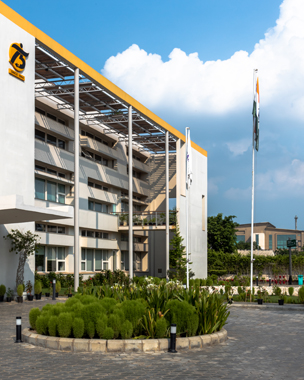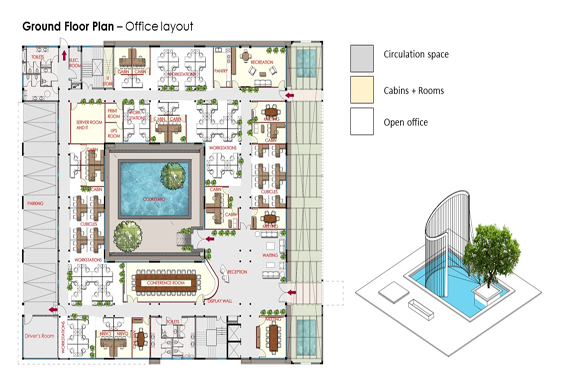Unnati Office
Greater NOIDA, Uttar Pradesh
Lighting Design
An energy-efficient lighting system with daylighting controls is used.
Energy-efficient fixtures and ballasts contribute to a 66% reduction in lighting energy compared to Standard 90.1-2010.
Occupancy sensors in normally unoccupied areas like storage areas, toilets and mechanical rooms minimize lighting use.
Lighting controls ensure minimum internal heat gain and reduced air-conditioning load in those spaces.
Approximately 90% of total regularly occupied spaces in the building have an illuminance level of 300-3000 lux measured on the clearest sky conditions. A lighting power density (LPD) of 3.6W/m2 in all occupied spaces is significantly lower than the Standard 90.1-2010 baseline of 10.9 W/m2.
The building uses energy-saving technologies associated with the electrical power supply system/building management system.
Optimized Energy Systems / HVAC system
The building has a hybrid HVAC system which is a combination of water-cooled air handling units and ceiling-embedded radiant cooling system.
Cooling load distribution of the system is such that 55% of the load is met by the radiant cooling system and 45% by AHUs. Total
cooling load for the project is around 90 TR for which 2# 80 TR screw chillers (1 Working + 1 Stand-by) are provided.
Based on indoor design conditions of 24°C and 55% relative humidity, the room dew-point temperature is 12°C and chilled water is supplied at a temperature 7°C to avoid any condensation on surfaces.
Indoor Air Quality
Dry outdoor ventilation air is supplied through an externally mounted unit that dehumidifies the air before it is supplied to occupied space. This dry outdoor air acts as primary air to the chilled beams.
The air quality is monitored inside the entire building with help of CO2 sensors which provide an audible alarm
The DOAS system starts at 8 a.m. to remove moisture that builds up during unoccupied hours and brings down the temperature to desired level before office start-up.
Metering and Monitoring
Advanced energy metered systems include the main incoming power supply, chillers, internal lighting, external lighting, air-handling units, the water supply system, the sewage treatment plant and the solar PV system.
Commissioning
The project incorporated ASHRAE-recommended commissioning methodology, using a third-party commissioning agent and energy auditor.
Commissioning through all four phases – design, construction, acceptance, and occupancy – ensured proper implementation of the building envelope, mechanical and electrical systems.





